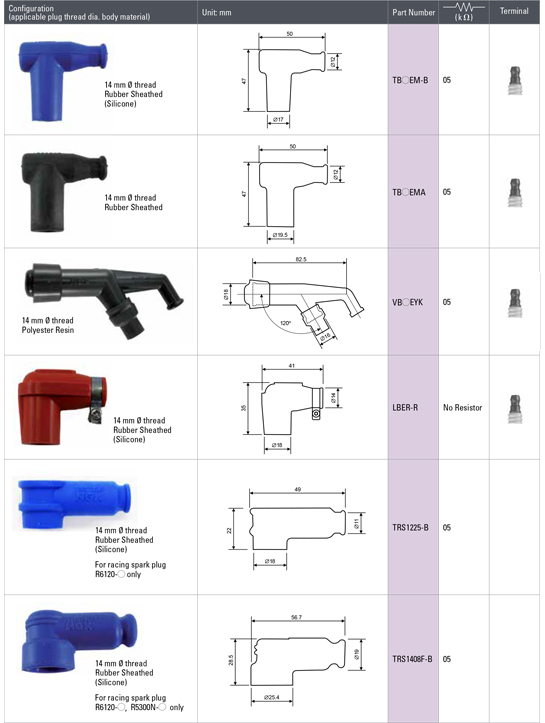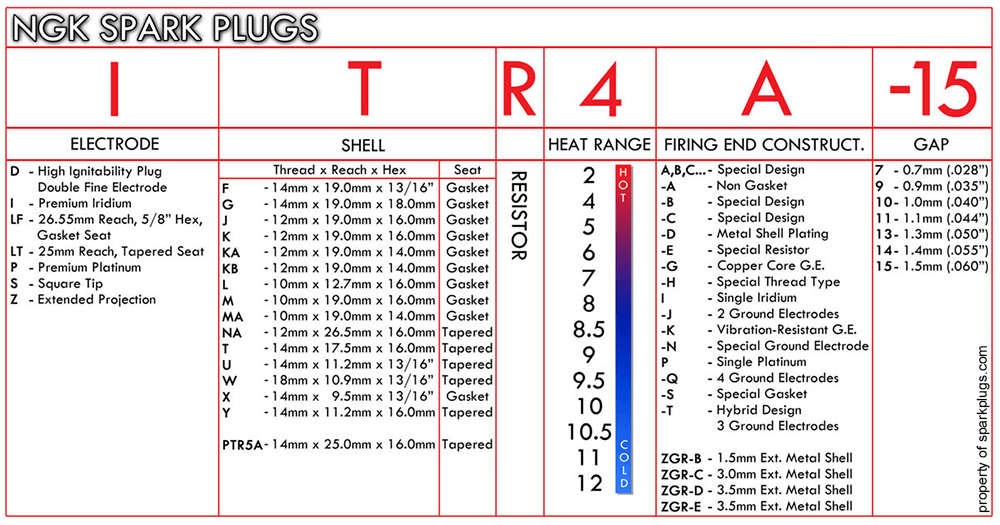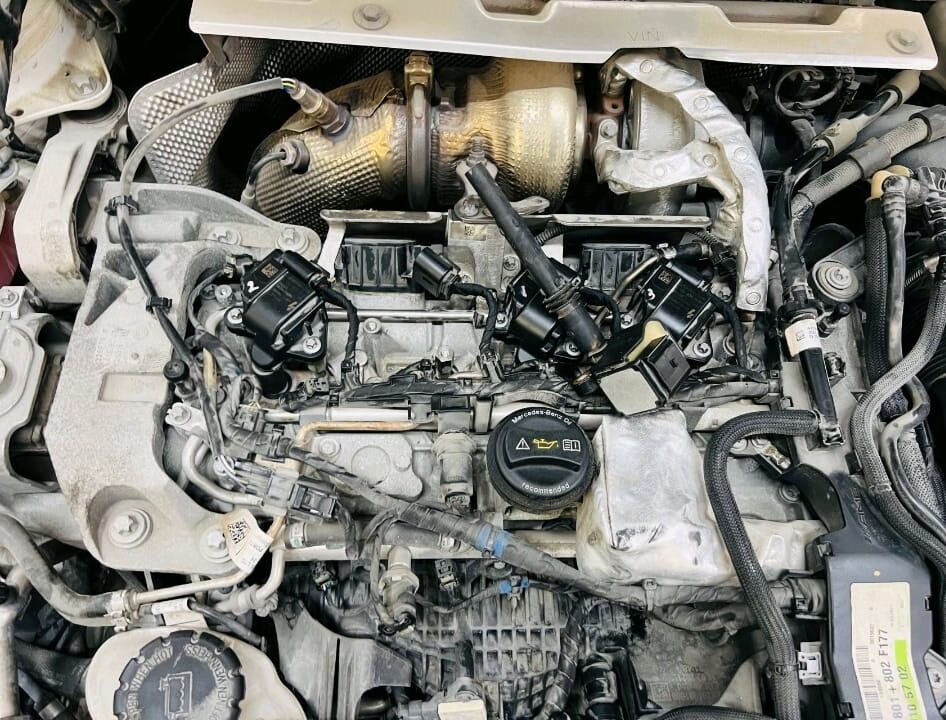NGK Spark Plug Cap Chart helps identify the correct spark plug cap based on specifications like thread size, resistance, and terminal type. It ensures optimal engine performance by providing the right cap for secure connections, interference suppression, and proper ignition in various vehicle applications.
When it comes to maintaining and improving engine performance, one of the most important yet overlooked components is the spark plug cap. NGK Spark Plug Cap Chart is an essential tool for selecting the right spark plug cap for your engine. By understanding how different spark plug caps affect your engine’s ignition system, you can ensure smoother, more efficient performance and prevent issues like misfires, poor combustion, and reduced engine lifespan.
This guide will provide a deep dive into the NGK Spark Plug Cap Chart, explain its importance, and give you the information you need to make the best choice for your vehicle.

Contents
What is an NGK Spark Plug Cap?
An NGK Spark Plug Cap is a component that plays an important role in the ignition system of the engine. It connects the spark plug to the ignition wire, enabling the electrical current to pass through to the spark plug, which then ignites the air-fuel mixture in the combustion chamber. The spark plug cap is not just a simple connector; it also serves as a resistor, helping to suppress electromagnetic interference (EMI) and ensuring that your engine operates smoothly without misfires or electrical disruptions.
The NGK Spark Plug Cap Chart provides a detailed overview of the various types of caps available, their specifications, and how to choose the right one based on your engine’s needs. From thread size to resistance values, terminal types, and materials, this chart helps you make informed decisions that can optimize your engine’s performance.
Why Is the NGK Spark Plug Cap Important?
The NGK Spark Plug Cap serves several vital functions in your engine’s ignition system:
- Electromagnetic Interference Suppression: Some spark plug caps are designed with resistance that helps reduce electromagnetic interference. This ensures that the engine’s ignition system operates smoothly and that other electrical systems in the vehicle are not affected by ignition signals.
- Secure Connection: The spark plug cap connects the ignition wire to the spark plug securely. A loose connection can lead to misfires or poor engine performance.
- Durability and Fitment: NGK Spark Plug Caps are made of durable materials that ensure long-lasting performance, even under extreme heat conditions. It is essential to choose the correct cap to avoid premature wear and tear.
- Improved Combustion Efficiency: The correct spark plug cap ensures that the spark plug fires at the right time, which helps optimize combustion and improves engine efficiency.
NGK Spark Plug Cap Chart: Key Specifications
The NGK Spark Plug Cap Chart provides vital information about various caps, including their thread size, resistance value, terminal type, material, and angle. Let’s take a closer look at the different specifications:
1. Thread Size
The thread size indicates the diameter of the spark plug cap’s connection to the spark plug. Common thread sizes are:
- 10mm: Typically used in smaller engines such as motorcycles and ATVs.
- 12mm: Commonly found in larger engines, including cars and trucks.
Choosing the correct thread size is crucial for proper fitment. Using the wrong size can result in poor connections, which can lead to engine misfires or inefficient combustion.
2. Resistance (Measured in Ohms)
Resistance is an essential feature that indicates how much the spark plug cap resists the flow of electrical current. This resistance is necessary to suppress electromagnetic interference, which can disrupt other vehicle electronics.
- 0Ω: No resistance. These are typically used for racing or performance applications where EMI suppression is not as critical.
- 5kΩ: The most common resistance found in standard NGK spark plug caps. It provides a balance between EMI suppression and performance.
- 10kΩ: Used in some applications requiring higher levels of EMI suppression, such as older vehicles or certain racing engines.
3. Terminal Type
The terminal type refers to the connection point between the spark plug cap and the ignition wire. Common types include:
- Nut: This is the most common terminal type and is used in various applications.
- Stud: Often found in racing or heavy-duty vehicles, the stud terminal offers a more secure connection.
- Threaded Post: This type is used in some high-performance applications where secure and robust connections are needed.
4. Material
Spark plug caps are made from different materials that influence their durability and heat resistance. Common materials include:
- Phenolic Resin: Known for its high heat resistance and durability, it’s commonly used in standard spark plug caps.
- EPDM Rubber: A more flexible material, ideal for applications where vibration resistance is critical.
5. Angle
The angle of the spark plug cap determines how the ignition wire is routed. Common angles include:
- 90°: Most common, provides a standard route for the ignition wire.
- 120°: Offers a more flexible fit, often used in tight engine bays.
- Straight (180°): Used in engines where there is enough space for the ignition wire to run in a straight line.
How to Choose the Right NGK Spark Plug Cap for the Engine
Choosing the right spark plug cap requires understanding your engine’s requirements. Here’s a step-by-step guide to help you select the best NGK Spark Plug Cap:
1. Check the Thread Size
Always start by checking the thread size of your spark plug. This information is typically available in your vehicle’s manual or printed on the spark plug itself. Most vehicles use either a 10mm or 12mm thread size.
2. Determine the Required Resistance
The resistance needed depends on your vehicle’s ignition system and whether you’re using the vehicle for performance or daily driving. For regular driving, a 5kΩ resistance is ideal. If you’re using the vehicle in a performance application, you may opt for a 0Ω cap.
3. Select the Terminal Type
Choose the terminal type that fits your ignition wire. Most applications will use a nut terminal, but high-performance or heavy-duty vehicles may require a stud terminal for a more secure connection.
4. Material Selection
For most applications, phenolic resin is a great choice due to its heat resistance and durability. However, if vibration is a concern, especially in racing applications, EPDM rubber may be a better option.
5. Choose the Right Angle
The angle of the spark plug cap is important for fitment. Ensure that the cap you choose allows for proper routing of the ignition wire without interference from other engine components.
NGK Spark Plug Cap Chart Breakdown
Here’s an example of what the NGK Spark Plug Cap Chart looks like:
| Part Number | Thread Size | Resistance | Terminal Type | Material | Angle |
|---|---|---|---|---|---|
| LB05E | 14mm | 5kΩ | Nut | Phenolic Resin | 90° |
| SB05F | 14mm | 5kΩ | Stud | EPDM Rubber | 90° |
| XD05F | 10mm | 5kΩ | Nut | Phenolic Resin | 90° |
| VB05F | 14mm | 5kΩ | Nut | EPDM Rubber | 120° |
| XB05F | 14mm | 5kΩ | Nut | EPDM Rubber | Straight |
Frequently Asked Questions
Here are some FAQs about the NGK spark plug cap chart –
1. What is the purpose of a spark plug cap?
A spark plug cap connects the spark plug to the ignition wire, transmitting electrical current to the spark plug for ignition. It also suppresses electromagnetic interference and ensures secure, efficient operation.
2. How do I know which spark plug cap to choose?
Choose a spark plug cap based on your engine’s thread size, resistance requirement, terminal type, material, and angle. Check your vehicle’s manual for specific recommendations.
3. Can I use any spark plug cap with any spark plug?
No, you need to select a spark plug cap that matches the spark plug’s specifications, including thread size and resistance, to ensure proper operation and performance.
4. What is resistance in a spark plug cap?
Resistance, measured in ohms (Ω), is the ability of the cap to suppress electromagnetic interference (EMI). Higher resistance helps reduce electrical noise but may slightly affect performance in racing engines.
5. Where can I find the NGK Spark Plug Cap Chart?
The NGK Spark Plug Cap Chart is available on NGK’s official website and through authorized distributors.
Conclusion
The NGK Spark Plug Cap Chart is an invaluable resource for anyone looking to optimize their engine’s ignition system. By understanding the key specifications—thread size, resistance, terminal type, material, and angle—you can make informed decisions that enhance your engine’s performance and longevity. Always consult the NGK Spark Plug Cap Chart before selecting a spark plug cap to ensure compatibility with your vehicle’s ignition system.
Note: Please refer to NGK’s official website and authorized distributors for the most up-to-date and accurate information on spark plug caps.





